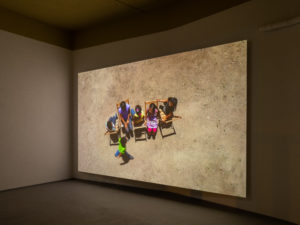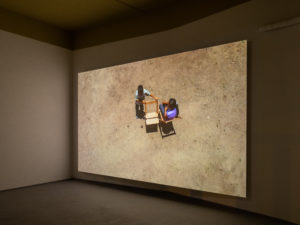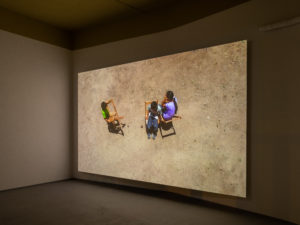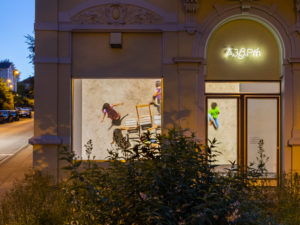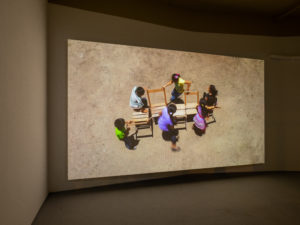9.22 Francis Alÿs Children’s Game #12: Sillas musicales (Musical Chairs)
More
Walking in public space has been an essential part of his practice since the early 1990s. His strolls (Paseos) engage with his everyday life as a foreigner (European) in megametropolis Mexico City and take up its historical and social contrasts; the resulting works, including at times highly conceptual pieces, interventions, performances, and photographic series, have earned him international renown. In his dual role as observer and participant, resident and artist, Alÿs has mapped the surroundings around his studio near the Zócalo over the course of many years. His explorations seemingly casually document the political, social, and historical layers of his adopted city and weave them into urban tales.
Since 1999, Alÿs has filmed children at play all over the world. His exhibition activities and travels have taken him to almost every continent on earth—hotspots and peaceful countries alike. His Children’s Games series comprises just over thirty videos at present, all numbered chronologically. It shows children skimming flat stones across the water in Morocco (#2), French skipping in France (#4), flying homemade kites in Afghanistan (#10), playing with a cloth ball in Nepal (#17), leapfrogging over one other’s backs in Iraq (#20), playing a country-specific version of mancala in Congo (#26), and snail racing real gastropods in Belgium (#31). The children seldom play on their own; instead they are mostly seen playing in groups, competing in some instances and cooperating in others. While some games seem extremely recognizable and familiar from one’s own childhood—tag, jumping rope, skipping rocks, flying kites—others are typical of a particular country or specific to a geographic region, and not globally widespread. The videos capture youngsters and their interactions in the game, often in a single take and from the children’s point of view. The only perceptible audio is the original sound; the artist deliberately refrains from additional explanations. Indications as to the location and name of the game appear only in the title and opening credits. All of the films oscillate heavily between objective documentation and participatory observation; the closeness of the recording conveys the lightness and joy of play.
Alÿs’s Children’s Game #12: Sillas musicales (Musical Chairs), Oaxaca, Mexico (2012) is captured in a single, overhead take. Six children can be seen setting up five folding chairs in a row, one after the other, for a game of musical chairs. With the start of the song “Tus Ojos Negros” (Engl.: Your Black Eyes) by the Mexican band Super Lamas, the boys and girls circle the row of chairs in a clockwise direction. Without warning, the music stops. Each child rushes to sit on a free chair as quickly as possible. One player is inevitably left standing, is eliminated and removes a chair from the playing field. Finally, a girl wins against a boy of the same approximate age. We see little of their surroundings; a dusty dirt ground dominates the screen. A rooster crows briefly near the beginning and end of the video. The title of the work points to the place of its production: the state/city of Oaxaca in southern Mexico.
Children’s Games finds Alÿs conducting a kind of artistic field research, his approach resembling that of an ethnologist minus the purely objective or systematically scientific procedure. At the heart of his subjective interest is the human being as a cultural, social creature that plays for the sake of playing. In play we find a negotiation between order and chaos, consensus and dissent, self and other, the individual and the many. It is a learning process we all master on our way to becoming social, cultural beings. The artist has also pointed to an analogy between his own approach to work and the rules of a game: “I realized the importance that children’s games had had as an inspiration not so much of the scripts but of the mechanics of my works: the absurd logic of very clear rules which did not have much sense in themselves. I am not very good at defining what is that I am looking for, but it is crystal clear when it is that I am out of bounds. Children’s games are like that: the moment you step out of the rules of the game, children will complain to you. Sometimes rules are not well defined, but there is a clear limit between being in or outside of a game.”¹
As a child, Alÿs was fascinated by Children’s Games, c. 1560. The opulent, detailed painting by Pieter Bruegel the Elder offers an encyclopedic view of the children’s games of his time, many of which are waiting to be rediscovered. The reference highlights Alÿs’s focus on the universal nature of children’s play with the intent of creating a cultural archive of children’s games—before they are lost as a cultural practice or can no longer be passed on to the next generation. The commonality, the linking factor shared by all people (children) across all cultures is not only play as a generic characteristic of humans, or play as a life experiment and key vehicle for learning and creativity, but rather the purposelessness associated with play—and with art.
Francis Alÿs (b. 1959 in Belgium) lives and works in Mexico City. He studied architecture before turning entirely to his art practice, which encompasses painting, drawing, animation, and video. His work addresses ethnological and geopolitical issues through observation and engagement with everyday life. Recent output includes a series of new projects in Iraq, culminating with the historical fiction film Sandlines, the Story of History, 2018–20. His Children’s Games series (ongoing since 1999) is an anthology of children at play around the world. Alÿs also developed a series of new films in the Democratic Republic of Congo, Belgium, Canada, and Hong Kong for presentation in the Belgian Pavilion at the 59th Venice Biennale (2022), where they are being shown in conjunction with paintings and drawings. Alÿs’s work has featured in prestigious museums and art institutions around the world and is included in major collections.
Since 1999, Alÿs has filmed children at play all over the world. His exhibition activities and travels have taken him to almost every continent on earth—hotspots and peaceful countries alike. His Children’s Games series comprises just over thirty videos at present, all numbered chronologically. It shows children skimming flat stones across the water in Morocco (#2), French skipping in France (#4), flying homemade kites in Afghanistan (#10), playing with a cloth ball in Nepal (#17), leapfrogging over one other’s backs in Iraq (#20), playing a country-specific version of mancala in Congo (#26), and snail racing real gastropods in Belgium (#31). The children seldom play on their own; instead they are mostly seen playing in groups, competing in some instances and cooperating in others. While some games seem extremely recognizable and familiar from one’s own childhood—tag, jumping rope, skipping rocks, flying kites—others are typical of a particular country or specific to a geographic region, and not globally widespread. The videos capture youngsters and their interactions in the game, often in a single take and from the children’s point of view. The only perceptible audio is the original sound; the artist deliberately refrains from additional explanations. Indications as to the location and name of the game appear only in the title and opening credits. All of the films oscillate heavily between objective documentation and participatory observation; the closeness of the recording conveys the lightness and joy of play.
Alÿs’s Children’s Game #12: Sillas musicales (Musical Chairs), Oaxaca, Mexico (2012) is captured in a single, overhead take. Six children can be seen setting up five folding chairs in a row, one after the other, for a game of musical chairs. With the start of the song “Tus Ojos Negros” (Engl.: Your Black Eyes) by the Mexican band Super Lamas, the boys and girls circle the row of chairs in a clockwise direction. Without warning, the music stops. Each child rushes to sit on a free chair as quickly as possible. One player is inevitably left standing, is eliminated and removes a chair from the playing field. Finally, a girl wins against a boy of the same approximate age. We see little of their surroundings; a dusty dirt ground dominates the screen. A rooster crows briefly near the beginning and end of the video. The title of the work points to the place of its production: the state/city of Oaxaca in southern Mexico.
Children’s Games finds Alÿs conducting a kind of artistic field research, his approach resembling that of an ethnologist minus the purely objective or systematically scientific procedure. At the heart of his subjective interest is the human being as a cultural, social creature that plays for the sake of playing. In play we find a negotiation between order and chaos, consensus and dissent, self and other, the individual and the many. It is a learning process we all master on our way to becoming social, cultural beings. The artist has also pointed to an analogy between his own approach to work and the rules of a game: “I realized the importance that children’s games had had as an inspiration not so much of the scripts but of the mechanics of my works: the absurd logic of very clear rules which did not have much sense in themselves. I am not very good at defining what is that I am looking for, but it is crystal clear when it is that I am out of bounds. Children’s games are like that: the moment you step out of the rules of the game, children will complain to you. Sometimes rules are not well defined, but there is a clear limit between being in or outside of a game.”¹
As a child, Alÿs was fascinated by Children’s Games, c. 1560. The opulent, detailed painting by Pieter Bruegel the Elder offers an encyclopedic view of the children’s games of his time, many of which are waiting to be rediscovered. The reference highlights Alÿs’s focus on the universal nature of children’s play with the intent of creating a cultural archive of children’s games—before they are lost as a cultural practice or can no longer be passed on to the next generation. The commonality, the linking factor shared by all people (children) across all cultures is not only play as a generic characteristic of humans, or play as a life experiment and key vehicle for learning and creativity, but rather the purposelessness associated with play—and with art.
Francis Alÿs (b. 1959 in Belgium) lives and works in Mexico City. He studied architecture before turning entirely to his art practice, which encompasses painting, drawing, animation, and video. His work addresses ethnological and geopolitical issues through observation and engagement with everyday life. Recent output includes a series of new projects in Iraq, culminating with the historical fiction film Sandlines, the Story of History, 2018–20. His Children’s Games series (ongoing since 1999) is an anthology of children at play around the world. Alÿs also developed a series of new films in the Democratic Republic of Congo, Belgium, Canada, and Hong Kong for presentation in the Belgian Pavilion at the 59th Venice Biennale (2022), where they are being shown in conjunction with paintings and drawings. Alÿs’s work has featured in prestigious museums and art institutions around the world and is included in major collections.
Children’s Game #12: Sillas musicales (Musical Chairs), Oaxaca, Mexico, 2012
Single channel video, color, sound
5:05 min.
In collaboration with Elena Pardo and Félix Blume
Courtesy the artist and Galerie Peter Kilchmann, Zurich
Text Cynthia Krell
Translation Amy Patton
¹Cuauhtémoc Medina, “A Collection of ‘Innumerable Little Allegories’: Francis Alÿs’s Children Games,” in Francis Alÿs, Children’s Games, eds. Marente Bloemheuvel and Jaap Guldemond, (Rotterdam: nai010 Publishers, 2019), 15.
Close
Single channel video, color, sound
5:05 min.
In collaboration with Elena Pardo and Félix Blume
Courtesy the artist and Galerie Peter Kilchmann, Zurich
Text Cynthia Krell
Translation Amy Patton
¹Cuauhtémoc Medina, “A Collection of ‘Innumerable Little Allegories’: Francis Alÿs’s Children Games,” in Francis Alÿs, Children’s Games, eds. Marente Bloemheuvel and Jaap Guldemond, (Rotterdam: nai010 Publishers, 2019), 15.

